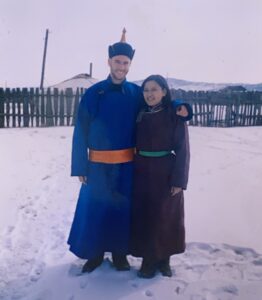My nine years in Mongolia were a journey of learning and adaptation.
 My first Tsagaan Sar was memorable because it involved extreme weather, celebrations, vodka, dozens of house parties, and thousands of dumplings. And I don’t remember the holiday ever ending. The warmth and community spirit of Tsagaan Sar made me feel like I was part of something much larger than myself.
My first Tsagaan Sar was memorable because it involved extreme weather, celebrations, vodka, dozens of house parties, and thousands of dumplings. And I don’t remember the holiday ever ending. The warmth and community spirit of Tsagaan Sar made me feel like I was part of something much larger than myself.
My nine years in Mongolia were a journey of learning and adaptation. On my first Tsagaan Sar, in the middle of winter and -40 degrees, I had already become adept at Mongolia village life. I chopped wood, hand-washed my clothes without running water, and used an outhouse, even when it was -40 outside. I learned that -40 is a unique temperature because there is no need to say “Fahrenheit” or “Celsius.” It’s the perfect cross-cultural temperature. Don’t believe me? Look it up.
I was a teacher at the local village school. The school principal gifted me a traditional Mongolian deel, a one-piece felt outfit. It was super warm, insulating my body like an oven. My eyelashes and nose hairs were frozen, and my cheeks were bright red from the pounding cold, but my body was warm.
During Tsagaan Sar, I was told to expect to go to “everyone’s house” and “everyone also goes to everyone else’s house.” At each house, everyone would be expected to eat at least three Mongolian mutton dumplings, a slice of sheep tail fat, a mayonnaise-based potato salad with pieces of sausage, drink salty milk tea with chunks of animal fat, and take three shots of vodka. I should also give gifts of cash to my elders and do a formal age-based greeting with everyone in each house by embracing their arms and then sniffing or kissing their cheeks or head or getting my cheeks/head sniffed/kissed. I should also expect to sing at least one Mongolian song at each home. There were many rules to follow, and I was worried. Also, I was speaking Mongolian – a language I had never even heard of the year before – what could go wrong? But as I navigated these cultural barriers, I felt a sense of accomplishment and joy that I had overcome them.
I like to think through logistics, so I asked questions like “How does everyone go to everyone else’s house simultaneously? Wouldn’t that mean that no one is ever home? How is this going to work without phones or other communication systems? How can everyone eat so much? How does everyone have so much food ready to host the equivalent of 50+ holiday parties? How many days does this last? Wouldn’t it make more sense not to exchange money since everyone gives the money they get to someone else? Why are we sniffing each other? What happens if I’m not a good singer?” I was told I asked too many questions.
I spent much time with my friend Tsevelmaa (“Tsevlee” for short) and her family during my first Tsagaan Sar. She was a fellow teacher at my school, and we had become good friends. All the logistics worked out, and I didn’t feel embarrassed. I fell in love with the holiday because it felt like a combination of Thanksgiving, Christmas, New Year’s, and Greek Easter. The holiday was all about new beginnings, spending time with loved ones, and living life to the fullest.
Fast-forward 20+ years. Tsevlee (who now goes by “Emma”) and I are about to celebrate this Tsagaan Sar next month, the beginning of the snake year. Oh, I forgot to mention that we are married and have three kids (23, 17, and 10). Mongolian has become my language, too, and I still speak it daily. We will celebrate this Tsagaan Sar in Northern Virginia, where we have lived for 12 years.
–George Economides (RPCV Bangladesh & Mongolia, 2001–2005; PC Staff 2008–2017; presently on the NPCA Board)